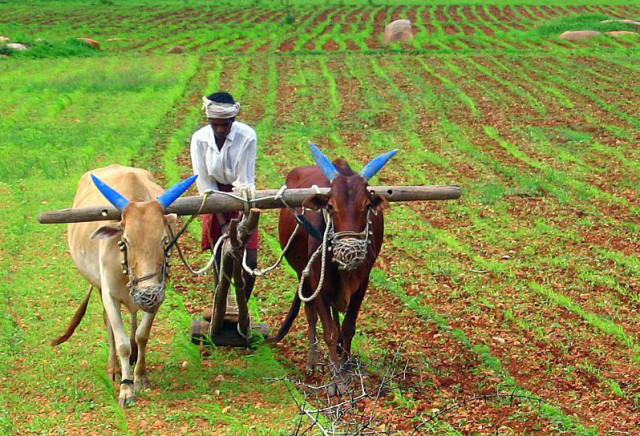That India’s agricultural sector is under stress is not a secret. Reams of newsprint have been written about the spate of farmer suicides that have become as much an epidemic as any disease over the last twelve years or so.

Image Courtesy : Wikipedia
To understand where this misery stems from, one needs to look at larger historical trends around the world. For centuries, the world’s population was on a very slow growth path, with natural disasters and wars, in addition to infant mortality and lack of neo-natal care accounting for a large number of deaths. The majority of people were engaged in agriculture, which was a profitable trade for the most part. With industrialisation and advancement in medical sciences came a spike in population as well as a shift away from agriculture.
For India, however, the industrial revolution never happened. While under colonial rule, India was allowed to continue to remain an agrarian economy, even as the medical benefits of modernity began to trickle into the country. At independence, despite the best and sincere efforts of the early governments, the ship had sailed for India. Too many members of a vast population still depended on agriculture. The technological advances made by the USA, Europe and Japan in manufacturing meant that India lagged too far behind in becoming competitive in production of industrial goods. For nearly thirty years this situation persisted, until the nationalisation of Banks was followed by a push towards rural banking. Recognising that a lack of credit was a significant bottleneck to agricultural welfare, a number of schemes were pushed to try to reduce dependence of farmers on money-lenders. Measures like the Green Revolution and fertiliser subsidies were implemented to make farming competitive.
With all this, however, the situation in 2016 remains dire. Farm credit it still very limited. Money-lenders have not gone away. As land reforms led to fragmentation of land holdings, the percentage of agricultural land held in sizes of a hectare of less has only increased. This is compounded by a failure in creating a sustainable irrigation network. 65% of the farms in India still depend on snow-fed rivers for irrigation. With climate change devastating normal weather patterns, the supply of water has dried up. The other issue is the growth of water-intensive crops across large parts of the country, another matter that is difficult to bring change to in the short term.
So what can we identify as the root causes of farmer distress?
- Lack of irrigation
- Climate change
- Inadequate access to credit.
- Growth of unsustainable crops
- Fragmented land holdings
It is evident that these are not problems that a single solution. Indeed, from drip-irrigation to co-operative farming, from ‘priority sector’ quotas for banks to subsidizing seeds and fertilisers, everything has been tried. A sustained effort has perhaps been lacking due to apathy – in a country increasingly driven by the media, we fail to see the value of anything that is not part of the 24-hour breaking news cycle.
A few things, however, can be undertaken to bring about the systemic changes necessary to make Indian agriculture viable again.
Encourage a movement away from farming
counter intuitive as it sounds, it is no longer feasible for India’s farmlands to sustain the bulk of its population. Neither can migration to cities be the answer to these problems. Endeavours like Startup India and Make In India must venture out of the urban cocoon and penetrate rural India.
Invest heavily in upgradation of farming technique.
It is time to recognise that age-old farming practices will not only not sustain India’s growing population, but will also not be profitable for the farmers.
Invest in logistics.
India’s infrastructure is woefully inadequate, and this affects no one as much as it does farmers. With produce rotting before it reaches markets, with vegetables necessarily grown close to point of consumption due to absence of cold chain storage, there is no chance of farm incomes rising unless the facilities exist to bring farm produce to the markets in time.
Shift to less water-intensive crops.
Adopting farming methods from countries like Japan or Holland which have a scarcity of land will yield better results than copying the American model, which is geared towards large land holdings and growing of corn and wheat.
Implement the priority sector lending norms more strictly.
Currently, despite the setting of a minimum requirement for farm sector loans, Banks are not meeting these targets. This needs to be more strictly implemented by the Reserve Bank
Whether by themselves, these measures will be relief to India’s farmers is debatable, but certainly without them, we are staring at a decade more of tragedy.






























Congratulations! Your post was selected for Buzzing Blogosphere on April 11, 2016 at BlogAdda
Please view your post here:
http://blog.blogadda.com/2016/04/11/buzzing-blogosphere-farmer-suicides-india